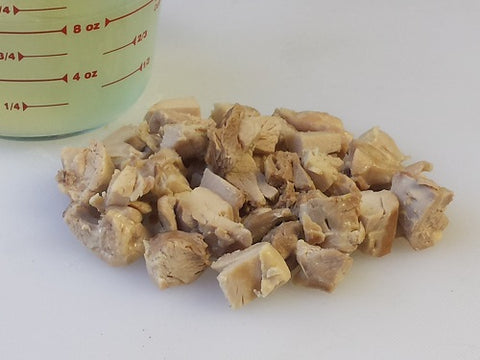Carb Solutions: Chicken “Noodle” Soup

By Dennis Linden
Over half of the U.S. adult population, some 154 million, qualify as being overweight or obese. Another 29 million of us have Diabetes, many as a direct result of being overweight. Then there are the 23.9 million overweight children who are dutifully following the example of their XXL adult role models. Diabetes and these extra pounds cost this country billions annually in both medical and economic resources; not to mention the affect these weight-related maladies have on a person’s overall mental well-being and happiness. However, both diabetes and being overweight are very manageable, even preventable, with a few lifestyle tweaks. By maintaining a sensible diet in conjunction with some consistent exercise, no matter how minimal, we can all be in total control of our own weight. One easy way to start taking that control is to make decisions about the foods we eat based on the glycemic index [GI] and glycemic load [GL].
Simply put, our bodies convert all foods into sugar calories that provide energy to the body via the blood stream. The Glycemic Index assigns a score of 1 to 100 to all foods based how speedy the body converts that food into sugar. Foods that break down slowly enable the body to assimilate theses calories of energy more efficiently without overwhelming the body with more sugar than it can process. While this is especially important for diabetics who process sugars much slower than others, everyone can benefit from eating foods that have low glycemic scores since they also reduce appetite and encourage the metabolism to burn body fat. Conversely, a diet of foods high on the glycemic charts have been proven to actually increase appetite and impede effective fat oxidation.
A Quickie Glycemic Primer:
- The glycemic index of a food compares its effect on blood sugar level to that of pure glucose, which has a score of 100. White breads, which are made of processed white flour, are at the top of this scale, scoring a “perfect” 100 on the glycemic index. For perspective, a score of 55 or below denotes a low-glycemic-index food; 70 or above is considered very high. Serving size is not a consideration in arriving at a food’s Glycemic Index number.
- The glycemic load, on the other hand, focuses on how much digestible carbohydrates (sugars) a food contains in a typical single serving, which is defined as approximately 3.5 ounces. For glycemic load, a score of 20 or more is high, while 10 or less is low.
I would never suggest that a yellow squash, no matter how skillfully sliced, can take the place of pasta completely in texture and taste. While these squash noodles would not make a satisfying substitute for a plate of spaghetti, as a soup component this dish really does play tricks on the palate both visually as well as texturally if cooked just right. After all, we do eat with our eyes first and this soup definitely raises expectations by the looks of it to be, in fact, chicken noodle soup! Texture is the next challenge. To that point, add in the julienned squash during the last five minutes of the simmer. In fact, the squash will continue to cook a bit in the hot broth off the flame, so err on the side of under-cooked. It’s a delicate al dente balance; if the squash noodles get too “squashy” this dish simply will not work.
Of course, a good soup is all about the flavors of the broth. In a perfect world this soup is the tastiest using a homemade chicken broth that has been simmered for hours and strained after an over-night chill. For the rest of us with busy lives this recipe combines a store-brought broth with some of the leftover liquid from cooking up the chicken. It’s not quite a short-cut to real homemade, admittedly, but the fat content in the chicken water mixed with the processed broth does add a little “fresher” flavor.
Obviously, the point to this recipe is the yellow squash noodle alternative to the flour-based, high glycemic alternative. The rest of the soup ingredients listed are a pretty straightforward traditional formula using a few fresh veggies for flavoring. It goes without saying that if you have your mother’s chicken soup recipe, use it and just swap out the pasta. A flavorful broth will be absorbed by the neutral-tasting squash just as well as a neutral-tasting pasta with none – as in zero – of the calories and carbs. Enjoy! And if you have a case of the spring sniffles…have a second bowl and get well soon!
Low Carb Chicken “Noodle” Soup
Servings: 4

Ingredients:
1 Skinless, Boneless Chicken Breast or two Thighs, boiled & cubed, retain 2 cups liquid from the boil
6 cups Chicken Broth
1 stalk Celery, diced
1 medium Carrot, diced
1 Leek, chopped
½ Red Bell Pepper, diced
1 small Yellow Squash, small julienne
4 Tablespoons Fresh Parsley, chopped
Salt and Pepper, to taste
Preparation:

Boil chicken in a medium sauce pan until cooked through. Retain 2 cups of water. Dice cooked chicken.

Using the “small julienne” attachment, mandolin the yellow squash into approximately 3-inch lengths. Discard the seedy core.

Dice carrot, celery and red bell pepper; chop leeks and parsley.

Combine water from chicken and store-bought broth in a large soup pot, then bring to boil. Add the celery, carrot, red pepper and leeks. Turn down to a simmer and cook for 15-20 minutes until the carrots and celery are tender.

Add the yellow squash “noodles”, parsley, salt and pepper, then simmer for another 5 minutes until squash is no longer crunchy, but also not mushy. Garnish with a pinch of fresh parsley just before serving.

